HLTH101 Essay: Research Analysis of Facilitated Communication
VerifiedAdded on 2022/08/25
|7
|1469
|17
Essay
AI Summary
This essay provides a comprehensive research analysis of facilitated communication, also known as supported typing, a technique used to assist individuals with disabilities such as autism, cerebral palsy, and intellectual disabilities. The essay begins by defining facilitated communication and its place within Augmented and Alternative Communication (AAC), while also acknowledging the American Speech Language Hearing Association's (ASHA) stance that there is no scientific evidence supporting its validity. The literature review explores both supporting and opposing research, including studies by Foster (2019), which highlights the origins and early promotion of facilitated communication, and researchautism.net (2017), which outlines its key features. The essay also examines the controversies surrounding facilitated communication, including the debate over authorship and the concerns raised by the ASHA and other researchers. It critically analyzes the findings of Hemsley et al. (2018), which found no new evidence supporting the technique, and Auerbach (2015), who expressed concerns about its practice. The essay also includes a conflicting study by Bigozzi et al. (2012) that supports the use of facilitated communication. Ultimately, the essay concludes that while facilitated communication remains a controversial topic, it can be beneficial when used with supervision and in a cautious manner.
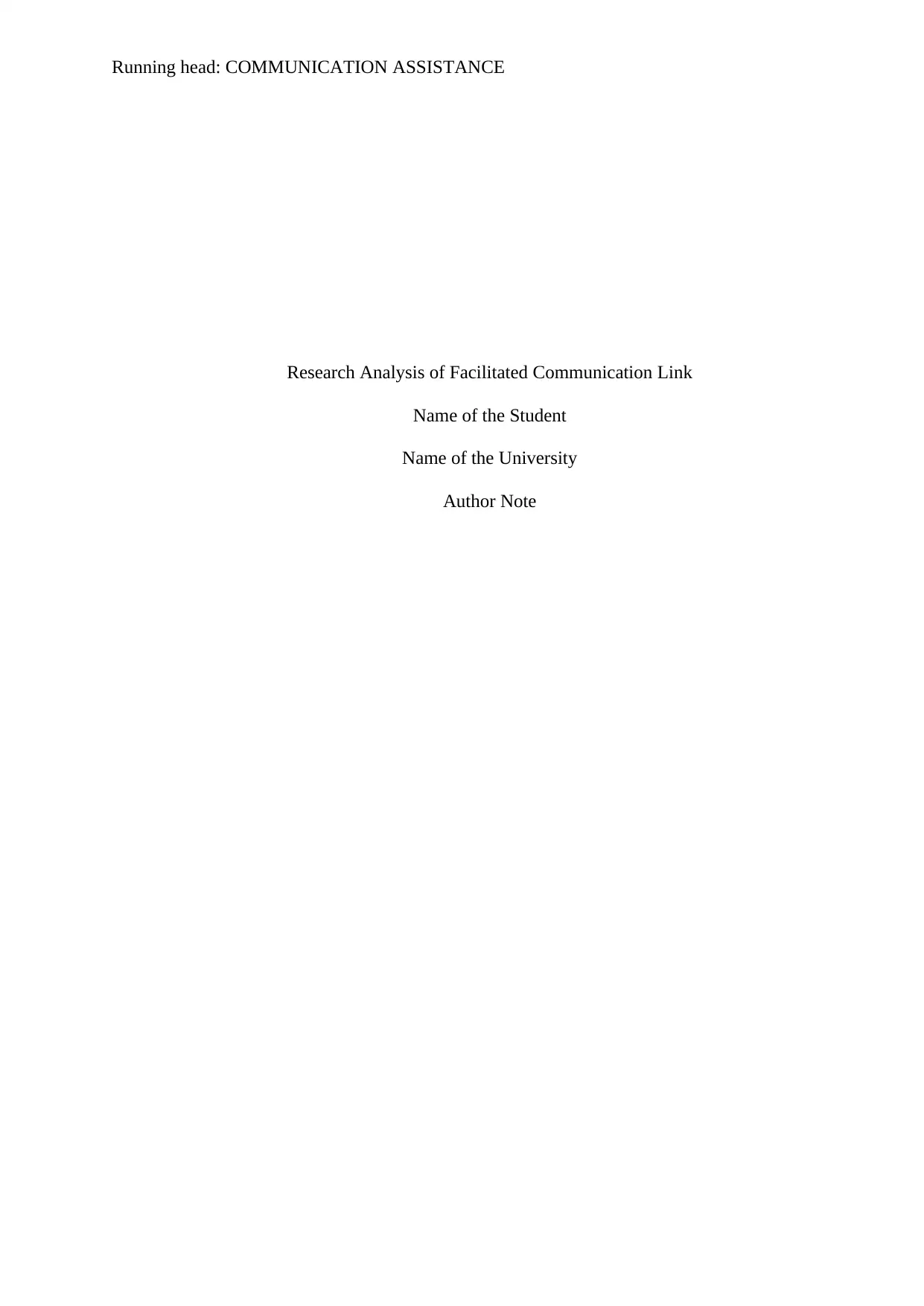
Running head: COMMUNICATION ASSISTANCE
Research Analysis of Facilitated Communication Link
Name of the Student
Name of the University
Author Note
Research Analysis of Facilitated Communication Link
Name of the Student
Name of the University
Author Note
Paraphrase This Document
Need a fresh take? Get an instant paraphrase of this document with our AI Paraphraser
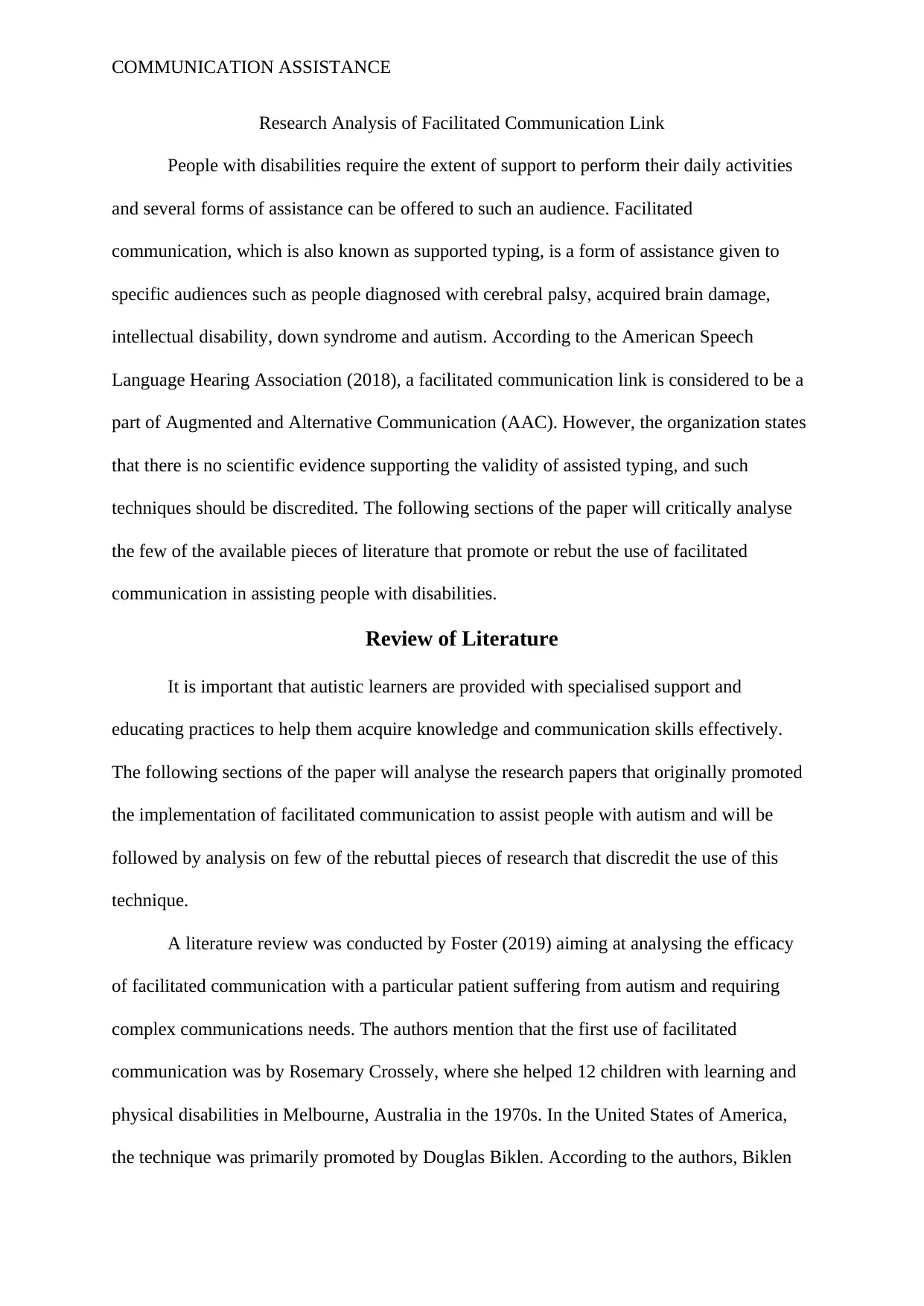
COMMUNICATION ASSISTANCE
Research Analysis of Facilitated Communication Link
People with disabilities require the extent of support to perform their daily activities
and several forms of assistance can be offered to such an audience. Facilitated
communication, which is also known as supported typing, is a form of assistance given to
specific audiences such as people diagnosed with cerebral palsy, acquired brain damage,
intellectual disability, down syndrome and autism. According to the American Speech
Language Hearing Association (2018), a facilitated communication link is considered to be a
part of Augmented and Alternative Communication (AAC). However, the organization states
that there is no scientific evidence supporting the validity of assisted typing, and such
techniques should be discredited. The following sections of the paper will critically analyse
the few of the available pieces of literature that promote or rebut the use of facilitated
communication in assisting people with disabilities.
Review of Literature
It is important that autistic learners are provided with specialised support and
educating practices to help them acquire knowledge and communication skills effectively.
The following sections of the paper will analyse the research papers that originally promoted
the implementation of facilitated communication to assist people with autism and will be
followed by analysis on few of the rebuttal pieces of research that discredit the use of this
technique.
A literature review was conducted by Foster (2019) aiming at analysing the efficacy
of facilitated communication with a particular patient suffering from autism and requiring
complex communications needs. The authors mention that the first use of facilitated
communication was by Rosemary Crossely, where she helped 12 children with learning and
physical disabilities in Melbourne, Australia in the 1970s. In the United States of America,
the technique was primarily promoted by Douglas Biklen. According to the authors, Biklen
Research Analysis of Facilitated Communication Link
People with disabilities require the extent of support to perform their daily activities
and several forms of assistance can be offered to such an audience. Facilitated
communication, which is also known as supported typing, is a form of assistance given to
specific audiences such as people diagnosed with cerebral palsy, acquired brain damage,
intellectual disability, down syndrome and autism. According to the American Speech
Language Hearing Association (2018), a facilitated communication link is considered to be a
part of Augmented and Alternative Communication (AAC). However, the organization states
that there is no scientific evidence supporting the validity of assisted typing, and such
techniques should be discredited. The following sections of the paper will critically analyse
the few of the available pieces of literature that promote or rebut the use of facilitated
communication in assisting people with disabilities.
Review of Literature
It is important that autistic learners are provided with specialised support and
educating practices to help them acquire knowledge and communication skills effectively.
The following sections of the paper will analyse the research papers that originally promoted
the implementation of facilitated communication to assist people with autism and will be
followed by analysis on few of the rebuttal pieces of research that discredit the use of this
technique.
A literature review was conducted by Foster (2019) aiming at analysing the efficacy
of facilitated communication with a particular patient suffering from autism and requiring
complex communications needs. The authors mention that the first use of facilitated
communication was by Rosemary Crossely, where she helped 12 children with learning and
physical disabilities in Melbourne, Australia in the 1970s. In the United States of America,
the technique was primarily promoted by Douglas Biklen. According to the authors, Biklen
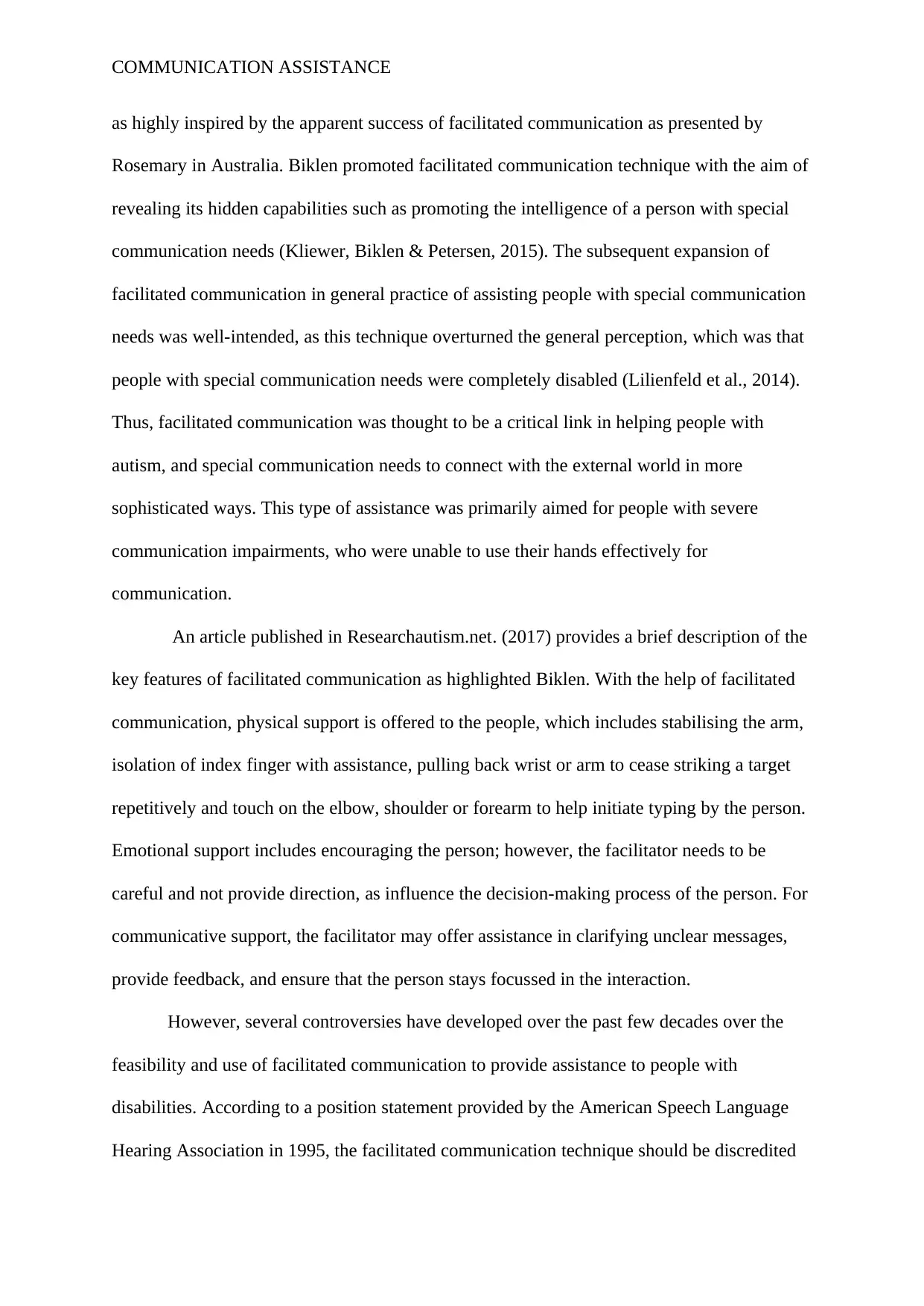
COMMUNICATION ASSISTANCE
as highly inspired by the apparent success of facilitated communication as presented by
Rosemary in Australia. Biklen promoted facilitated communication technique with the aim of
revealing its hidden capabilities such as promoting the intelligence of a person with special
communication needs (Kliewer, Biklen & Petersen, 2015). The subsequent expansion of
facilitated communication in general practice of assisting people with special communication
needs was well-intended, as this technique overturned the general perception, which was that
people with special communication needs were completely disabled (Lilienfeld et al., 2014).
Thus, facilitated communication was thought to be a critical link in helping people with
autism, and special communication needs to connect with the external world in more
sophisticated ways. This type of assistance was primarily aimed for people with severe
communication impairments, who were unable to use their hands effectively for
communication.
An article published in Researchautism.net. (2017) provides a brief description of the
key features of facilitated communication as highlighted Biklen. With the help of facilitated
communication, physical support is offered to the people, which includes stabilising the arm,
isolation of index finger with assistance, pulling back wrist or arm to cease striking a target
repetitively and touch on the elbow, shoulder or forearm to help initiate typing by the person.
Emotional support includes encouraging the person; however, the facilitator needs to be
careful and not provide direction, as influence the decision-making process of the person. For
communicative support, the facilitator may offer assistance in clarifying unclear messages,
provide feedback, and ensure that the person stays focussed in the interaction.
However, several controversies have developed over the past few decades over the
feasibility and use of facilitated communication to provide assistance to people with
disabilities. According to a position statement provided by the American Speech Language
Hearing Association in 1995, the facilitated communication technique should be discredited
as highly inspired by the apparent success of facilitated communication as presented by
Rosemary in Australia. Biklen promoted facilitated communication technique with the aim of
revealing its hidden capabilities such as promoting the intelligence of a person with special
communication needs (Kliewer, Biklen & Petersen, 2015). The subsequent expansion of
facilitated communication in general practice of assisting people with special communication
needs was well-intended, as this technique overturned the general perception, which was that
people with special communication needs were completely disabled (Lilienfeld et al., 2014).
Thus, facilitated communication was thought to be a critical link in helping people with
autism, and special communication needs to connect with the external world in more
sophisticated ways. This type of assistance was primarily aimed for people with severe
communication impairments, who were unable to use their hands effectively for
communication.
An article published in Researchautism.net. (2017) provides a brief description of the
key features of facilitated communication as highlighted Biklen. With the help of facilitated
communication, physical support is offered to the people, which includes stabilising the arm,
isolation of index finger with assistance, pulling back wrist or arm to cease striking a target
repetitively and touch on the elbow, shoulder or forearm to help initiate typing by the person.
Emotional support includes encouraging the person; however, the facilitator needs to be
careful and not provide direction, as influence the decision-making process of the person. For
communicative support, the facilitator may offer assistance in clarifying unclear messages,
provide feedback, and ensure that the person stays focussed in the interaction.
However, several controversies have developed over the past few decades over the
feasibility and use of facilitated communication to provide assistance to people with
disabilities. According to a position statement provided by the American Speech Language
Hearing Association in 1995, the facilitated communication technique should be discredited
⊘ This is a preview!⊘
Do you want full access?
Subscribe today to unlock all pages.

Trusted by 1+ million students worldwide
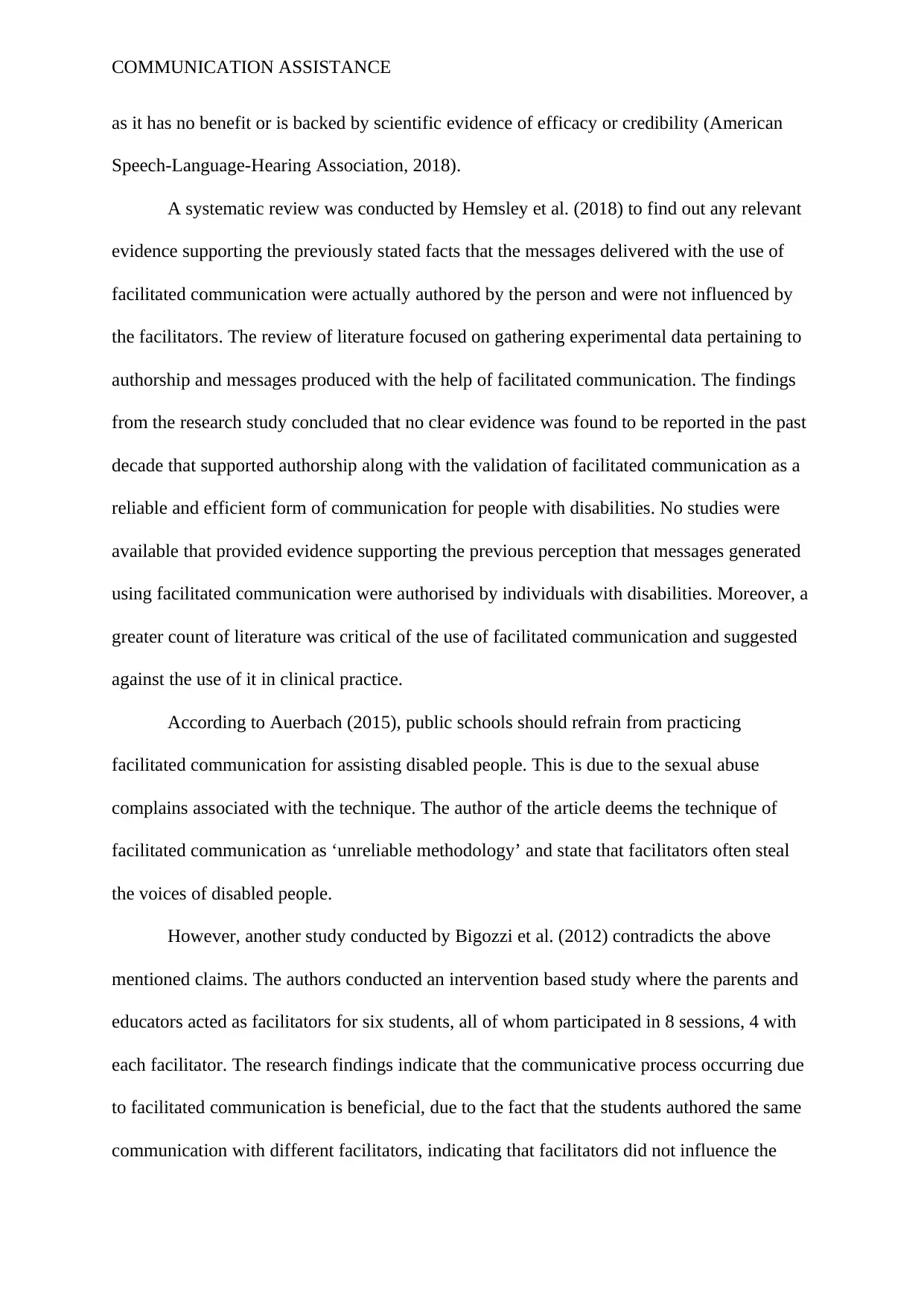
COMMUNICATION ASSISTANCE
as it has no benefit or is backed by scientific evidence of efficacy or credibility (American
Speech-Language-Hearing Association, 2018).
A systematic review was conducted by Hemsley et al. (2018) to find out any relevant
evidence supporting the previously stated facts that the messages delivered with the use of
facilitated communication were actually authored by the person and were not influenced by
the facilitators. The review of literature focused on gathering experimental data pertaining to
authorship and messages produced with the help of facilitated communication. The findings
from the research study concluded that no clear evidence was found to be reported in the past
decade that supported authorship along with the validation of facilitated communication as a
reliable and efficient form of communication for people with disabilities. No studies were
available that provided evidence supporting the previous perception that messages generated
using facilitated communication were authorised by individuals with disabilities. Moreover, a
greater count of literature was critical of the use of facilitated communication and suggested
against the use of it in clinical practice.
According to Auerbach (2015), public schools should refrain from practicing
facilitated communication for assisting disabled people. This is due to the sexual abuse
complains associated with the technique. The author of the article deems the technique of
facilitated communication as ‘unreliable methodology’ and state that facilitators often steal
the voices of disabled people.
However, another study conducted by Bigozzi et al. (2012) contradicts the above
mentioned claims. The authors conducted an intervention based study where the parents and
educators acted as facilitators for six students, all of whom participated in 8 sessions, 4 with
each facilitator. The research findings indicate that the communicative process occurring due
to facilitated communication is beneficial, due to the fact that the students authored the same
communication with different facilitators, indicating that facilitators did not influence the
as it has no benefit or is backed by scientific evidence of efficacy or credibility (American
Speech-Language-Hearing Association, 2018).
A systematic review was conducted by Hemsley et al. (2018) to find out any relevant
evidence supporting the previously stated facts that the messages delivered with the use of
facilitated communication were actually authored by the person and were not influenced by
the facilitators. The review of literature focused on gathering experimental data pertaining to
authorship and messages produced with the help of facilitated communication. The findings
from the research study concluded that no clear evidence was found to be reported in the past
decade that supported authorship along with the validation of facilitated communication as a
reliable and efficient form of communication for people with disabilities. No studies were
available that provided evidence supporting the previous perception that messages generated
using facilitated communication were authorised by individuals with disabilities. Moreover, a
greater count of literature was critical of the use of facilitated communication and suggested
against the use of it in clinical practice.
According to Auerbach (2015), public schools should refrain from practicing
facilitated communication for assisting disabled people. This is due to the sexual abuse
complains associated with the technique. The author of the article deems the technique of
facilitated communication as ‘unreliable methodology’ and state that facilitators often steal
the voices of disabled people.
However, another study conducted by Bigozzi et al. (2012) contradicts the above
mentioned claims. The authors conducted an intervention based study where the parents and
educators acted as facilitators for six students, all of whom participated in 8 sessions, 4 with
each facilitator. The research findings indicate that the communicative process occurring due
to facilitated communication is beneficial, due to the fact that the students authored the same
communication with different facilitators, indicating that facilitators did not influence the
Paraphrase This Document
Need a fresh take? Get an instant paraphrase of this document with our AI Paraphraser
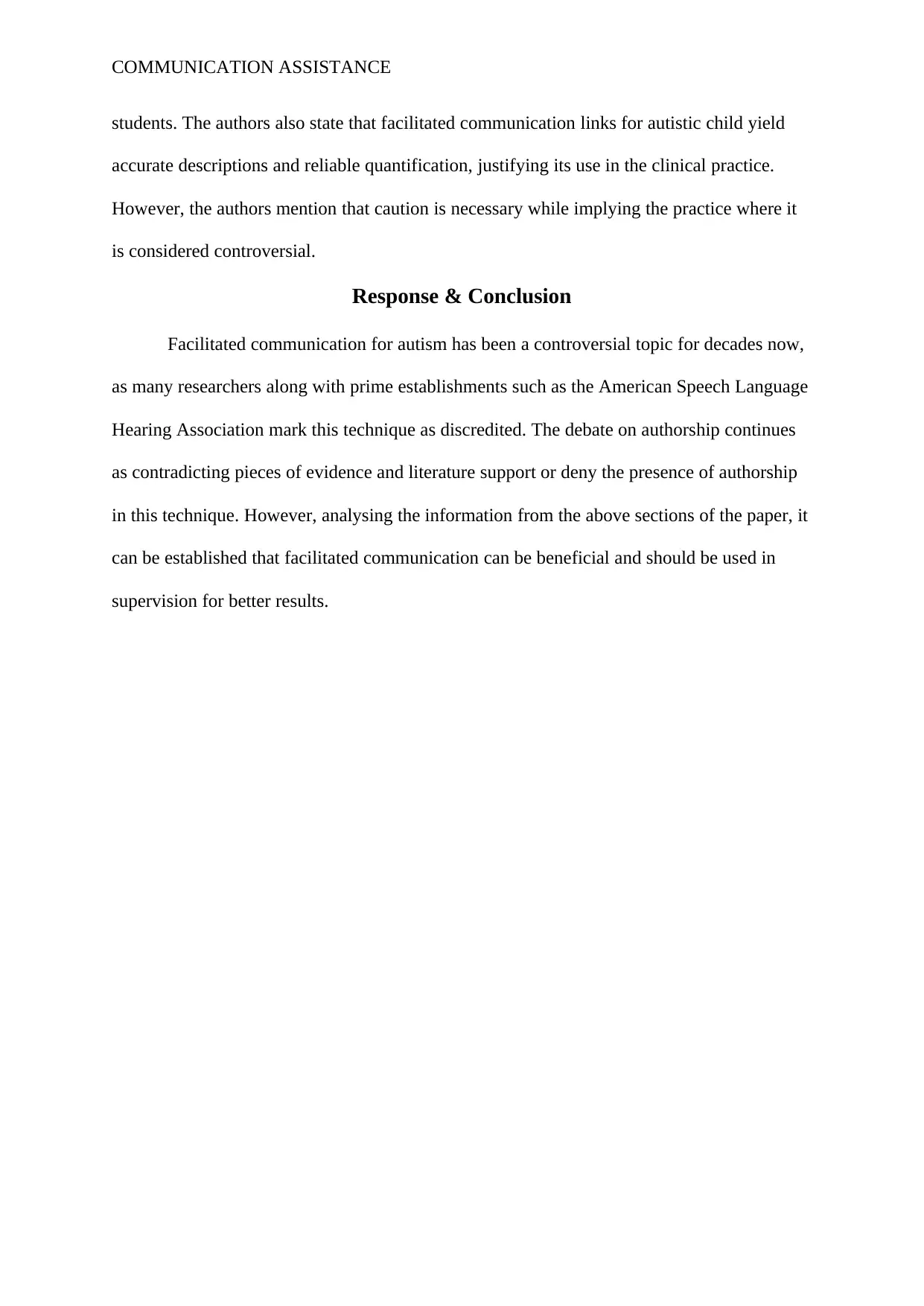
COMMUNICATION ASSISTANCE
students. The authors also state that facilitated communication links for autistic child yield
accurate descriptions and reliable quantification, justifying its use in the clinical practice.
However, the authors mention that caution is necessary while implying the practice where it
is considered controversial.
Response & Conclusion
Facilitated communication for autism has been a controversial topic for decades now,
as many researchers along with prime establishments such as the American Speech Language
Hearing Association mark this technique as discredited. The debate on authorship continues
as contradicting pieces of evidence and literature support or deny the presence of authorship
in this technique. However, analysing the information from the above sections of the paper, it
can be established that facilitated communication can be beneficial and should be used in
supervision for better results.
students. The authors also state that facilitated communication links for autistic child yield
accurate descriptions and reliable quantification, justifying its use in the clinical practice.
However, the authors mention that caution is necessary while implying the practice where it
is considered controversial.
Response & Conclusion
Facilitated communication for autism has been a controversial topic for decades now,
as many researchers along with prime establishments such as the American Speech Language
Hearing Association mark this technique as discredited. The debate on authorship continues
as contradicting pieces of evidence and literature support or deny the presence of authorship
in this technique. However, analysing the information from the above sections of the paper, it
can be established that facilitated communication can be beneficial and should be used in
supervision for better results.
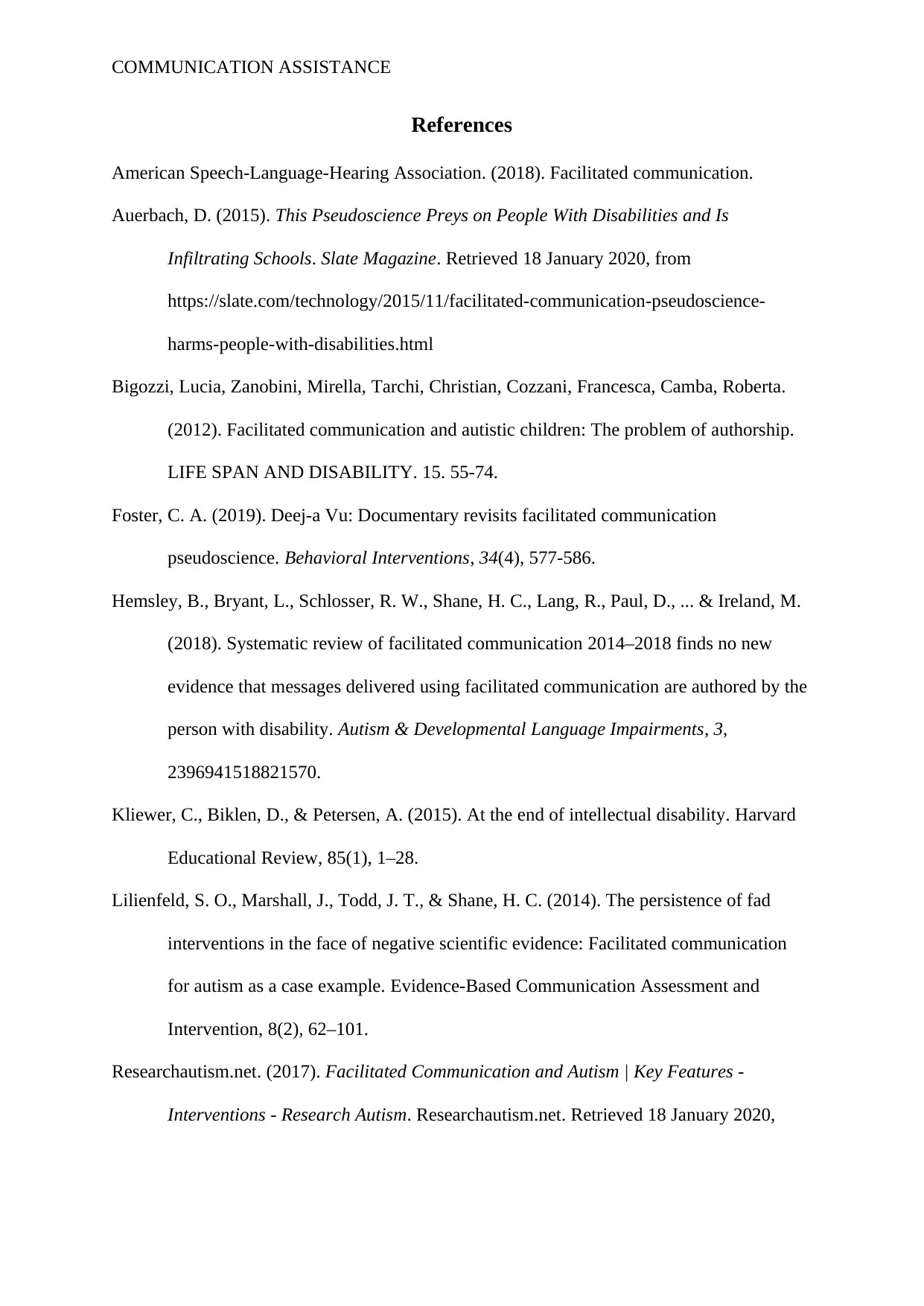
COMMUNICATION ASSISTANCE
References
American Speech-Language-Hearing Association. (2018). Facilitated communication.
Auerbach, D. (2015). This Pseudoscience Preys on People With Disabilities and Is
Infiltrating Schools. Slate Magazine. Retrieved 18 January 2020, from
https://slate.com/technology/2015/11/facilitated-communication-pseudoscience-
harms-people-with-disabilities.html
Bigozzi, Lucia, Zanobini, Mirella, Tarchi, Christian, Cozzani, Francesca, Camba, Roberta.
(2012). Facilitated communication and autistic children: The problem of authorship.
LIFE SPAN AND DISABILITY. 15. 55-74.
Foster, C. A. (2019). Deej‐a Vu: Documentary revisits facilitated communication
pseudoscience. Behavioral Interventions, 34(4), 577-586.
Hemsley, B., Bryant, L., Schlosser, R. W., Shane, H. C., Lang, R., Paul, D., ... & Ireland, M.
(2018). Systematic review of facilitated communication 2014–2018 finds no new
evidence that messages delivered using facilitated communication are authored by the
person with disability. Autism & Developmental Language Impairments, 3,
2396941518821570.
Kliewer, C., Biklen, D., & Petersen, A. (2015). At the end of intellectual disability. Harvard
Educational Review, 85(1), 1–28.
Lilienfeld, S. O., Marshall, J., Todd, J. T., & Shane, H. C. (2014). The persistence of fad
interventions in the face of negative scientific evidence: Facilitated communication
for autism as a case example. Evidence-Based Communication Assessment and
Intervention, 8(2), 62–101.
Researchautism.net. (2017). Facilitated Communication and Autism | Key Features -
Interventions - Research Autism. Researchautism.net. Retrieved 18 January 2020,
References
American Speech-Language-Hearing Association. (2018). Facilitated communication.
Auerbach, D. (2015). This Pseudoscience Preys on People With Disabilities and Is
Infiltrating Schools. Slate Magazine. Retrieved 18 January 2020, from
https://slate.com/technology/2015/11/facilitated-communication-pseudoscience-
harms-people-with-disabilities.html
Bigozzi, Lucia, Zanobini, Mirella, Tarchi, Christian, Cozzani, Francesca, Camba, Roberta.
(2012). Facilitated communication and autistic children: The problem of authorship.
LIFE SPAN AND DISABILITY. 15. 55-74.
Foster, C. A. (2019). Deej‐a Vu: Documentary revisits facilitated communication
pseudoscience. Behavioral Interventions, 34(4), 577-586.
Hemsley, B., Bryant, L., Schlosser, R. W., Shane, H. C., Lang, R., Paul, D., ... & Ireland, M.
(2018). Systematic review of facilitated communication 2014–2018 finds no new
evidence that messages delivered using facilitated communication are authored by the
person with disability. Autism & Developmental Language Impairments, 3,
2396941518821570.
Kliewer, C., Biklen, D., & Petersen, A. (2015). At the end of intellectual disability. Harvard
Educational Review, 85(1), 1–28.
Lilienfeld, S. O., Marshall, J., Todd, J. T., & Shane, H. C. (2014). The persistence of fad
interventions in the face of negative scientific evidence: Facilitated communication
for autism as a case example. Evidence-Based Communication Assessment and
Intervention, 8(2), 62–101.
Researchautism.net. (2017). Facilitated Communication and Autism | Key Features -
Interventions - Research Autism. Researchautism.net. Retrieved 18 January 2020,
⊘ This is a preview!⊘
Do you want full access?
Subscribe today to unlock all pages.

Trusted by 1+ million students worldwide

COMMUNICATION ASSISTANCE
from http://www.researchautism.net/interventions/16/facilitated-communication-and-
autism/keyfeatures
from http://www.researchautism.net/interventions/16/facilitated-communication-and-
autism/keyfeatures
1 out of 7
Related Documents
Your All-in-One AI-Powered Toolkit for Academic Success.
+13062052269
info@desklib.com
Available 24*7 on WhatsApp / Email
![[object Object]](/_next/static/media/star-bottom.7253800d.svg)
Unlock your academic potential
Copyright © 2020–2025 A2Z Services. All Rights Reserved. Developed and managed by ZUCOL.





